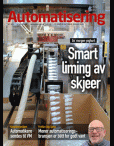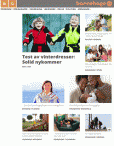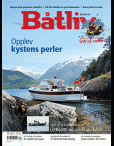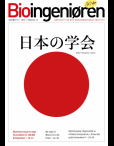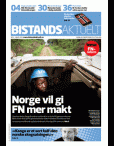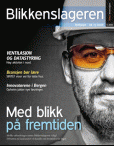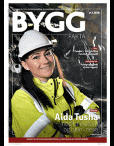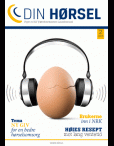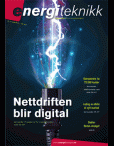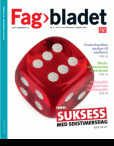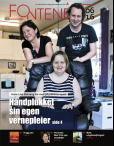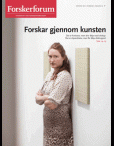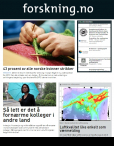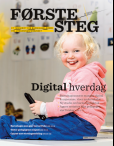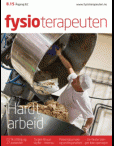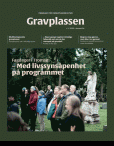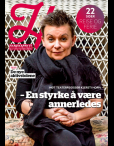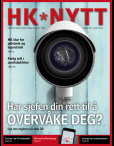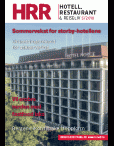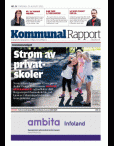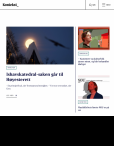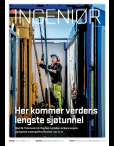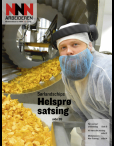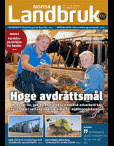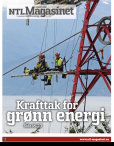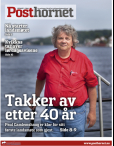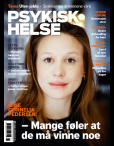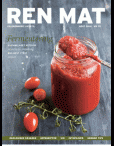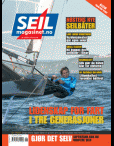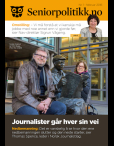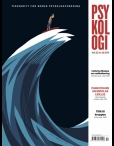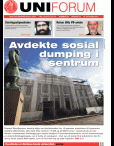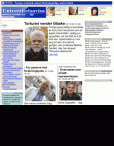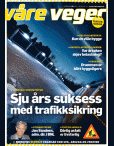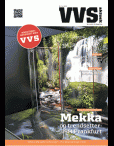Magma
30.10.2018

INTRODUCTION
Companies that continuously search for opportunities to innovate and redesign their business model are found to achieve higher growth rates and return to market share (e.g. Lindgardt et al., 2009; Sosna et al., 2010). The need for innovative business models is especially relevant with regard to strengthening the competitiveness of Norwegian companies. With the onset of the “Fourth Industrial Revolution" (as it is referred to by some economists), we can expect an acceleration in
* Ingen av forfatterne er norskspråkelige, og artikkelen publiseres derfor på engelsk.
global competition paired with increased digitalization and shifting consumer trends that will contribute to the need for new business models that take advantage of these ongoing developments.
Notably, many of the top 100 world's most innovative companies are not known for their massive R&D spending or technological leadership (Saebi, 2016). What differentiates these companies from less innovative ones is their ability to incorporate innovative thinking into their business model design. Results from the recent Norwegian Innovation Index survey indicate that companies that are able to (1) deliver high-quality goods and services, (2) innovate on a regular basis, and (3) launch innovations that trigger active emotions are perceived as more attractive by customers, which, in turn, enhances customer loyalty towards the company (Andreassen, Lervik-Olsen & Kurtmollaiev, 2017a). However, “in a number of international rankings of nations' innovativeness, Norway lags far behind its neighbouring countries Sweden, Denmark and Finland" (Andreassen et al., 2017b). More specifically, a recent survey among Norwegian companies showed that only a small percentage of companies had innovated their business model in the past five years (Saebi & Singh, 2015). This raises the question of why, despite acknowledging the importance and necessity of engaging in innovation, many firms struggle to do so.
To date, academic research on this question is scant. Arguably, two main reasons account for this significant research gap. First, business model innovation (BMI) research is still at an early stage. Despite massive resonance in the academic as well as the practitioneroriented literature, Foss and Saebi (2017, p. 1) question “whether a true theory of BMI exists", and argue that literature on BMI does not just “face problems with respect to construct clarity [but also] has gaps with respect to the identification of antecedent conditions, contingencies, and outcomes".
Second, we lack qualitative research that investigates the challenges of BMI across different industries. As Christensen et al. (2016, p. 32) keenly observe, there is no “satisfactory theory for what's causing the problem, and under what circumstances it can be overcome". While some studies point towards the challenges of BMI, these studies either remain at a conceptual level or focus on a single case study (e.g. Sosna et al., 2010; McGrath, 2010; Chesbrough, 2010; Doz & Kosonen, 2010; Wirtz et al., 2010; Thompson & MacMillan, 2010; Smith et al., 2010).
Consequently, little is known about the facilitators and barriers for BMI. Therefore, in this study we first briefly review the concept of BMI to aid in a better understanding of its distinctive characteristics. Next, based on multiple interviews with Norwegian managers across different industries, we analyse the barriers and challenges associated with initiating and implementing BMI. Our findings lead to a better understanding of the innovation landscape in Norway. This insight can be particularly useful for managers as well as policymakers. While the interview data are limited to Norway, our results are potentially generalizable to countries with similar economic, cultural, and social structures.
THE STATE OF BUSINESS MODEL INNOVATION IN NORWAY
In 2015, researchers at the Center for Service Innovation conducted a survey on the state of business model innovation in Norway. Below, we briefly recapture the main findings of this survey as reported in Saebi and Singh (2015) as well as Saebi (2016). CEOs of companies across industries were asked whether changes to one or more components of their business model had taken place in the last five years (2010-2015), and whether these changes were new to the company
(business model adaptation) or new to the industry (business model innovation). Among the 284 companies surveyed in Norway, business model innovation appears to be in its infancy. The findings showed that if changes had taken place, these were limited to one or two business model components only, and companies were more likely to make modular changes to one business model component without affecting the core logic of their business. Further, only a small percentage of these changes can be qualified as innovative (for more information regarding data collection and measurement of core constructs, see Saebi and Singh, 2015; Saebi, 2016).
LITERATURE REVIEW
To understand why the level of business model innovation is low in Norway, it is essential to first clarify the concepts of business models (BM) and business model innovation (BMI) as these concepts are relatively new and lack established definitions.
Between 1995 and 2010, there have been over 1177 articles published in peer-reviewed academic journals that address the notion of a business model (Zott et al., 2011). Despite the increasing academic attention, there is still no commonly accepted definition and understanding of what business models are (Santos, Spector & Van Der Heyden, 2009; Zott et al., 2011; Foss & Saebi, 2018). Even in 2005, Shafer et al. (p. 200) describe the term as “desperately seeking definition", expressing the urgency of clarifying the term so that academic progress can be made in the term's development. As the concept of BM continues to grow in popularity, Zott et al. (2011, p. 2) point out that this “lack of definitional clarity promotes dispersion rather a convergence of the perspectives, hindering cumulative research progress on business models", and thus BMI. While many researchers acknowledge the obstacles in the lack of definitional clarity, this poses significant problems for practitioners, where “none of these definitions, however, have been accepted fully by the business community" (Shafer et al., 2005, p. 200). One of the earliest investigations of business models defined the term as “an architecture for the product, service and information flows, including a description of the various business actors and their roles; a description of the potential benefits for the various business actors; and a description of the sources of revenues" (Timmers, 1998, p. 2). Among the more frequently cited definitions of the business model are:
• “The content, structure, and governance of transactions designed so as to create value through the exploitation of business opportunities" (Amit & Zott, 2001, p. 1) • “The story of how the company works" (Magretta, 2002, p. 4) • “The organizational architecture for value creation, value delivery and value capture" (Teece, 2010, p. 172) • “The rationale of how an organization creates, delivers, and captures value" (Osterwalder & Pigneur, 2010, p. 14), and • “The logic of the firm, the way it operates and how it creates value for its stakeholders" (Casadesus & Ricart, 2010, p. 196).
While there is a divergence in the use of terminology, most studies concur on four main components of the business model, including the (1) target segment, (2) value proposition, (3) value capture, and (4) value delivery. Thus, we adopt these four components as the main defining elements of a business model.
WHAT IS BUSINESS MODEL INNOVATION AND WHY IS IT CHALLENGING?
Though practitioners and researchers identify innovative business models as a new and important source of competitive advantage (Chesbrough, 2010; Teece, 2010; Zott & Amit, 2007), no precise definition of BMI has yet emerged (Foss & Saebi, 2017, 2018). The lack of consensus regarding the definition of BM makes it increasingly difficult to conceptualize BMI, as there are variances in the way innovation is defined, “such as in terms of novelty or radicalness or the role business model innovation plays in enhancing a firm's performance" (Foss & Saebi, 2015, p. 7).
At a conceptual level, BMI has been defined as “the discovery of a fundamentally different business model in an existing business" (Markides, 2006, p. 20), or as the process of “designing a new, or modifying the firm's extant activity system" (Amit & Zott, 2010, p. 2). It thereby aims at actively renewing a firm's core business logic rather than limiting its scope of innovation to products and/or services. It also builds on the business model's capacity to integrate all of the firm's current business model components, external environment, and interfaces with customers and partners (Amit & Zott, 2010). Amit and Zott (2012, p. 5) continue to define BMI as consisting of “adding new activities, linking activities in novel ways, or changing which party performs an activity." We concur with Foss and Saebi's (2017, p. 2) definition of BMI as “designed, novel, nontrivial changes to the key elements of a firm's business model and/or the architecture linking these elements".
In most cases, BMI will require action and decisions from top management and might involve organizationwide changes in the way the company creates, delivers and captures value (Foss & Saebi, 2018). This can lead to several challenges as pointed out in extant literature. On regular basis, and (3) launch innovations that trigger active emotions are perceived as more attractive by customers, which, in turn, enhances customer loyalty towards the company (Andreassen, Lervik-Olsen & Kurtmollaiev, 2017a). However, “in a number of international rankings of nations' innovativeness, Norway lags far behind its neighbouring countries Sweden, Denmark and Finland" (Andreassen et al., 2017b). More specifically, a recent survey among Norwegian companies showed that only a small percentage of companies had innovated their business model in the past five years (Saebi & Singh, 2015). This raises the question of why, despite acknowledging the importance and necessity of engaging in innovation, many firms struggle to do so.
To date, academic research on this question is scant. Arguably, two main reasons account for this significant research gap. First, business model innovation (BMI) research is still at an early stage. Despite massive resonance in the academic as well as the practitioneroriented literature, Foss and Saebi (2017, p. 1) question “whether a true theory of BMI exists", and argue that literature on BMI does not just “face problems with respect to construct clarity [but also] has gaps with respect to the identification of antecedent conditions, contingencies, and outcomes".
Second, we lack qualitative research that investigates the challenges of BMI across different industries. As Christensen et al. (2016, p. 32) keenly observe, there is no “satisfactory theory for what's causing the problem, and under what circumstances it can be overcome". While some studies point towards the challenges of BMI, these studies either remain at a conceptual level or focus on a single case study (e.g. Sosna et al., 2010; McGrath, 2010; Chesbrough, 2010; Doz & Kosonen, 2010; Wirtz et al., 2010; Thompson & MacMillan, 2010; Smith et al., 2010).
Consequently, little is known about the facilitators and barriers for BMI. Therefore, in this study we first briefly review the concept of BMI to aid in a better understanding of its distinctive characteristics. Next, based on multiple interviews with Norwegian managers across different industries, we analyse the barriers and challenges associated with initiating and implementing BMI. Our findings lead to a better understanding of the innovation landscape in Norway. This insight can be particularly useful for managers as well as policymakers. While the interview data are limited to Norway, our results are potentially generalizable to countries with similar economic, cultural, and social structures.
THE STATE OF BUSINESS MODEL INNOVATION IN NORWAY
In 2015, researchers at the Center for Service Innovation conducted a survey on the state of business model innovation in Norway. Below, we briefly recapture the main findings of this survey as reported in Saebi and Singh (2015) as well as Saebi (2016). CEOs of companies across industries were asked whether changes to one or more components of their business model had taken place in the last five years (2010-2015), and whether these changes were new to the company
(business model adaptation) or new to the industry (business model innovation). Among the 284 companies
Gå til mediet* Ingen av forfatterne er norskspråkelige, og artikkelen publiseres derfor på engelsk.
global competition paired with increased digitalization and shifting consumer trends that will contribute to the need for new business models that take advantage of these ongoing developments.
Notably, many of the top 100 world's most innovative companies are not known for their massive R&D spending or technological leadership (Saebi, 2016). What differentiates these companies from less innovative ones is their ability to incorporate innovative thinking into their business model design. Results from the recent Norwegian Innovation Index survey indicate that companies that are able to (1) deliver high-quality goods and services, (2) innovate on a regular basis, and (3) launch innovations that trigger active emotions are perceived as more attractive by customers, which, in turn, enhances customer loyalty towards the company (Andreassen, Lervik-Olsen & Kurtmollaiev, 2017a). However, “in a number of international rankings of nations' innovativeness, Norway lags far behind its neighbouring countries Sweden, Denmark and Finland" (Andreassen et al., 2017b). More specifically, a recent survey among Norwegian companies showed that only a small percentage of companies had innovated their business model in the past five years (Saebi & Singh, 2015). This raises the question of why, despite acknowledging the importance and necessity of engaging in innovation, many firms struggle to do so.
To date, academic research on this question is scant. Arguably, two main reasons account for this significant research gap. First, business model innovation (BMI) research is still at an early stage. Despite massive resonance in the academic as well as the practitioneroriented literature, Foss and Saebi (2017, p. 1) question “whether a true theory of BMI exists", and argue that literature on BMI does not just “face problems with respect to construct clarity [but also] has gaps with respect to the identification of antecedent conditions, contingencies, and outcomes".
Second, we lack qualitative research that investigates the challenges of BMI across different industries. As Christensen et al. (2016, p. 32) keenly observe, there is no “satisfactory theory for what's causing the problem, and under what circumstances it can be overcome". While some studies point towards the challenges of BMI, these studies either remain at a conceptual level or focus on a single case study (e.g. Sosna et al., 2010; McGrath, 2010; Chesbrough, 2010; Doz & Kosonen, 2010; Wirtz et al., 2010; Thompson & MacMillan, 2010; Smith et al., 2010).
Consequently, little is known about the facilitators and barriers for BMI. Therefore, in this study we first briefly review the concept of BMI to aid in a better understanding of its distinctive characteristics. Next, based on multiple interviews with Norwegian managers across different industries, we analyse the barriers and challenges associated with initiating and implementing BMI. Our findings lead to a better understanding of the innovation landscape in Norway. This insight can be particularly useful for managers as well as policymakers. While the interview data are limited to Norway, our results are potentially generalizable to countries with similar economic, cultural, and social structures.
THE STATE OF BUSINESS MODEL INNOVATION IN NORWAY
In 2015, researchers at the Center for Service Innovation conducted a survey on the state of business model innovation in Norway. Below, we briefly recapture the main findings of this survey as reported in Saebi and Singh (2015) as well as Saebi (2016). CEOs of companies across industries were asked whether changes to one or more components of their business model had taken place in the last five years (2010-2015), and whether these changes were new to the company
(business model adaptation) or new to the industry (business model innovation). Among the 284 companies surveyed in Norway, business model innovation appears to be in its infancy. The findings showed that if changes had taken place, these were limited to one or two business model components only, and companies were more likely to make modular changes to one business model component without affecting the core logic of their business. Further, only a small percentage of these changes can be qualified as innovative (for more information regarding data collection and measurement of core constructs, see Saebi and Singh, 2015; Saebi, 2016).
LITERATURE REVIEW
To understand why the level of business model innovation is low in Norway, it is essential to first clarify the concepts of business models (BM) and business model innovation (BMI) as these concepts are relatively new and lack established definitions.
Between 1995 and 2010, there have been over 1177 articles published in peer-reviewed academic journals that address the notion of a business model (Zott et al., 2011). Despite the increasing academic attention, there is still no commonly accepted definition and understanding of what business models are (Santos, Spector & Van Der Heyden, 2009; Zott et al., 2011; Foss & Saebi, 2018). Even in 2005, Shafer et al. (p. 200) describe the term as “desperately seeking definition", expressing the urgency of clarifying the term so that academic progress can be made in the term's development. As the concept of BM continues to grow in popularity, Zott et al. (2011, p. 2) point out that this “lack of definitional clarity promotes dispersion rather a convergence of the perspectives, hindering cumulative research progress on business models", and thus BMI. While many researchers acknowledge the obstacles in the lack of definitional clarity, this poses significant problems for practitioners, where “none of these definitions, however, have been accepted fully by the business community" (Shafer et al., 2005, p. 200). One of the earliest investigations of business models defined the term as “an architecture for the product, service and information flows, including a description of the various business actors and their roles; a description of the potential benefits for the various business actors; and a description of the sources of revenues" (Timmers, 1998, p. 2). Among the more frequently cited definitions of the business model are:
• “The content, structure, and governance of transactions designed so as to create value through the exploitation of business opportunities" (Amit & Zott, 2001, p. 1) • “The story of how the company works" (Magretta, 2002, p. 4) • “The organizational architecture for value creation, value delivery and value capture" (Teece, 2010, p. 172) • “The rationale of how an organization creates, delivers, and captures value" (Osterwalder & Pigneur, 2010, p. 14), and • “The logic of the firm, the way it operates and how it creates value for its stakeholders" (Casadesus & Ricart, 2010, p. 196).
While there is a divergence in the use of terminology, most studies concur on four main components of the business model, including the (1) target segment, (2) value proposition, (3) value capture, and (4) value delivery. Thus, we adopt these four components as the main defining elements of a business model.
WHAT IS BUSINESS MODEL INNOVATION AND WHY IS IT CHALLENGING?
Though practitioners and researchers identify innovative business models as a new and important source of competitive advantage (Chesbrough, 2010; Teece, 2010; Zott & Amit, 2007), no precise definition of BMI has yet emerged (Foss & Saebi, 2017, 2018). The lack of consensus regarding the definition of BM makes it increasingly difficult to conceptualize BMI, as there are variances in the way innovation is defined, “such as in terms of novelty or radicalness or the role business model innovation plays in enhancing a firm's performance" (Foss & Saebi, 2015, p. 7).
At a conceptual level, BMI has been defined as “the discovery of a fundamentally different business model in an existing business" (Markides, 2006, p. 20), or as the process of “designing a new, or modifying the firm's extant activity system" (Amit & Zott, 2010, p. 2). It thereby aims at actively renewing a firm's core business logic rather than limiting its scope of innovation to products and/or services. It also builds on the business model's capacity to integrate all of the firm's current business model components, external environment, and interfaces with customers and partners (Amit & Zott, 2010). Amit and Zott (2012, p. 5) continue to define BMI as consisting of “adding new activities, linking activities in novel ways, or changing which party performs an activity." We concur with Foss and Saebi's (2017, p. 2) definition of BMI as “designed, novel, nontrivial changes to the key elements of a firm's business model and/or the architecture linking these elements".
In most cases, BMI will require action and decisions from top management and might involve organizationwide changes in the way the company creates, delivers and captures value (Foss & Saebi, 2018). This can lead to several challenges as pointed out in extant literature. On regular basis, and (3) launch innovations that trigger active emotions are perceived as more attractive by customers, which, in turn, enhances customer loyalty towards the company (Andreassen, Lervik-Olsen & Kurtmollaiev, 2017a). However, “in a number of international rankings of nations' innovativeness, Norway lags far behind its neighbouring countries Sweden, Denmark and Finland" (Andreassen et al., 2017b). More specifically, a recent survey among Norwegian companies showed that only a small percentage of companies had innovated their business model in the past five years (Saebi & Singh, 2015). This raises the question of why, despite acknowledging the importance and necessity of engaging in innovation, many firms struggle to do so.
To date, academic research on this question is scant. Arguably, two main reasons account for this significant research gap. First, business model innovation (BMI) research is still at an early stage. Despite massive resonance in the academic as well as the practitioneroriented literature, Foss and Saebi (2017, p. 1) question “whether a true theory of BMI exists", and argue that literature on BMI does not just “face problems with respect to construct clarity [but also] has gaps with respect to the identification of antecedent conditions, contingencies, and outcomes".
Second, we lack qualitative research that investigates the challenges of BMI across different industries. As Christensen et al. (2016, p. 32) keenly observe, there is no “satisfactory theory for what's causing the problem, and under what circumstances it can be overcome". While some studies point towards the challenges of BMI, these studies either remain at a conceptual level or focus on a single case study (e.g. Sosna et al., 2010; McGrath, 2010; Chesbrough, 2010; Doz & Kosonen, 2010; Wirtz et al., 2010; Thompson & MacMillan, 2010; Smith et al., 2010).
Consequently, little is known about the facilitators and barriers for BMI. Therefore, in this study we first briefly review the concept of BMI to aid in a better understanding of its distinctive characteristics. Next, based on multiple interviews with Norwegian managers across different industries, we analyse the barriers and challenges associated with initiating and implementing BMI. Our findings lead to a better understanding of the innovation landscape in Norway. This insight can be particularly useful for managers as well as policymakers. While the interview data are limited to Norway, our results are potentially generalizable to countries with similar economic, cultural, and social structures.
THE STATE OF BUSINESS MODEL INNOVATION IN NORWAY
In 2015, researchers at the Center for Service Innovation conducted a survey on the state of business model innovation in Norway. Below, we briefly recapture the main findings of this survey as reported in Saebi and Singh (2015) as well as Saebi (2016). CEOs of companies across industries were asked whether changes to one or more components of their business model had taken place in the last five years (2010-2015), and whether these changes were new to the company
(business model adaptation) or new to the industry (business model innovation). Among the 284 companies












